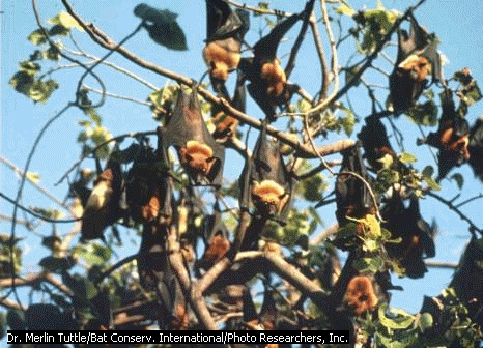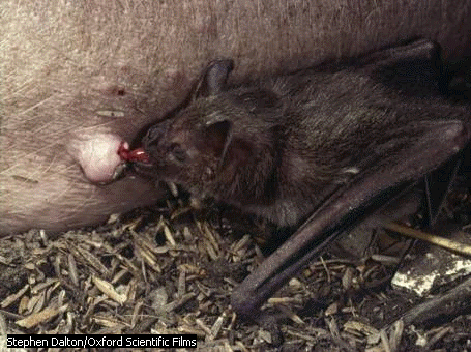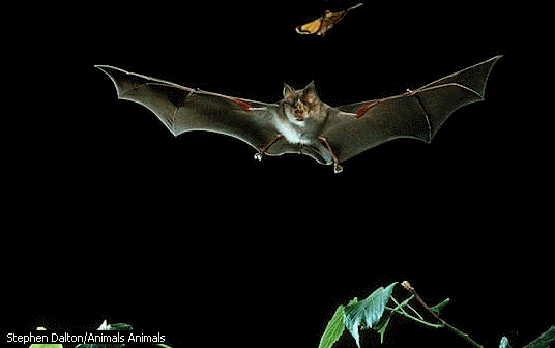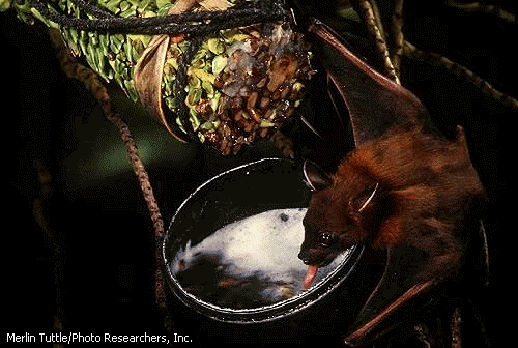Mammals
Bats
 Bats
are the only mammal that can fly. Bats have modified hands and arms
that serve as wings capable of sustained flight. They have been
flitting across the night
Bats
are the only mammal that can fly. Bats have modified hands and arms
that serve as wings capable of sustained flight. They have been
flitting across the night
skies for some 50 million years. In all this time, the physical
features of these animals have changed very little. Fossil specimens
from Europe and North America are nearly indistinguishable from
living forms.
There are nearly 1000 living bat species, accounting for almost a
quarter of all mammal species. These species are divided between two
major groups. The megabats are large animals, commonly known as Old
World fruit bats. They are mainly fruit-eaters and are found only in
tropical habitats of Africa, India, and Australia. The microbats are
smaller, eat a variety of foods from small mammals to fish, and are
much more widely distributed.
Nearly all bats are active at night or during the twilight of dawn
and dusk. To get around in the dark, many nocturnal bats rely on a
sophisticated form of sonar known as echolocation for navigating and
finding prey. Many bats have exceptionally good eyesight designed for
low levels of light. Only those bats that live on remote islands
lacking birds of prey routinely fly during the day.
In recent decades, people have begun to appreciate bats for their
beneficial roles. Bats are the most important natural enemies of
night-flying insect pests. Bats are important pollinators of plants,
pollinating at least 500 species. Without these helpful night fliers,
many bat-pollinated plants-and the many animals that depend on them
for food and shelter-would disappear from the earth.
RANGE AND HABITAT
Bats are found in all habitable regions of the earth, from the cold,
treeless plains of northern Canada to the rich tropical rain forests
of Borneo. The quantities of insects consumed by bats are
astonishing: as many as 250 tons of insects may be devoured by a
colony of Mexican free-tailed bats in a single night.
 During
the daytime, bats. Nearly all bats rest and sleep hanging upside
down by their hind feet; as a bat hangs, its own weight causes the
foot tendons to automatically grasp, firmly holding the animal in place.
During
the daytime, bats. Nearly all bats rest and sleep hanging upside
down by their hind feet; as a bat hangs, its own weight causes the
foot tendons to automatically grasp, firmly holding the animal in place.
Most species are colonial, roosting in dense clusters, often
comprising several thousand individuals. Wherever large numbers of
bats roost, huge piles of bat droppings, or guano, accumulates. In
many countries, guano is collected for fertilizer.
Only three species of bats can be called true vampire bats.
The common flying fox of Southeast Asia generally does not migrate
and may roost in the same tree throughout the year. The majority of
flying fox species do not use echolocation to navigate, as do most
other bats, but rely instead on their excellent eyesight.
PHYSICAL DESCRIPTION
Size
Bats range in body size from as small as 1 inch long, to as large as
the 16 inches long Malayan flying fox, which has a wingspan of 5.6
ft. The Kitti's hog-nosed bat is the world's smallest mammal, even
smaller than a shrew. Body weights of bats range from about 0.07
ounces to more than 2.9 pounds.
Wings
Bat wings are supported internally by modified hand bones the name of
the bat order, Chiroptera, is Greek for "hand-wing." Each
wing is made of a double layer of skin that stretches between the
bat's elongated finger bones and attaches to the side of the body and
the hind leg. The clawed thumb is free of the wing, and the bat uses
the thumb to cling to tree bark or the walls and ceiling of its
roost. Flying bats have been clocked at speeds as fast as 60 mph and
observed at altitudes of 2 miles. Unlike most birds, bats are able to
fly at relatively low speeds with extreme maneuverability.
Tails
The tails on bats are extremely variable. Many bats have no tail or
an extremely short tail that serves no purpose. Other bats, such as
the mouse-tailed bats, have a tail that is nearly as long as the
bat's body. In some species the tail is used as a net to catch
insects, while other species use the tail as a pouch to hold insects
until they can be eaten.
Fur
Bat fur is typically long, silky, and gray, but there are many
exceptions-notably the pale white northern ghost bat of tropical
America, the canary-hued yellow house bat of Africa, and the nearly
black greater spear-nosed bat of Central America. The painted bat has
scarlet fur and black and orange wings, which allows it to hide among
flowers. There is even one species of hairless, or naked, bat. The
primary function of bat fur is for warmth; however, some hairs
(especially those on the face and other exposed areas) receive and
transmit sensory impressions, much like the whiskers of cats or mice.
Faces
The faces of bats also vary considerably. Old World fruit bats have
long, narrow, fox-like muzzles, while common vampire bats and their
relatives possess short, pig-like snouts.
Ears
The ears of some species, including the aptly named long-eared bats,
are as long as the bat's entire body. On the other hand, the
black-bearded tomb bat has rather small ears. The shapes of bat ears
are extremely varied. The wide ears of the Australian false vampire
bat meet above the head and are fused. Many bats are able to turn
their ears in the direction of faint noises. Bat hearing and its use
in echolocation are highly developed.
Eyes
Some bats have large, conspicuous eyes, while others may have small
beady eyes. Despite the familiar expression, "blind as a
bat," none of these animals are truly sightless. On the
contrary, several bats can see better in dim light than do humans.
One species can perceive colors.
Teeth
Like most mammals, bats have two sets of teeth. Depending upon the
species, newborn bats are equipped with as many as 22 milk teeth.
These teeth are soon replaced with 20 to 28 permanent teeth. Bats
have widely differing teeth patterns specialized for the diverse
diets among the species, and teeth are often used to help identify
bat species. Flesh-eating, or carnivorous, bats, such as the false
vampire bats, have sharp and strong canine teeth for shearing flesh,
and strong molars for crushing bones. Insect-eating bats have molars
with sharp-edged surfaces that slide past each other in a
scissor-like motion ideal for grinding the hard outer shells of
insects. Fruit-eating bats have molars with large flat surfaces for grinding.
BEHAVIOR
Bats have been quite successful in diversifying to colonize many
different environments. To thrive in their varied habitats, bats
display a wide range of specialized behaviors, including
echolocation, diverse diets, and hibernation.
 Echolocation
Echolocation
While flying at night, bats use a combination of vision, smell, and
hearing to find food, to navigate, and to avoid collisions. The
Microchiroptera tend to rely heavily on a form of sonar called
echolocation. In echolocation, bats emit short pulses of
high-frequency sounds that are usually well above the threshold of
human hearing. The sound waves spread out in front of the bat,
striking any objects in its flight path and bouncing back in the form
of an echo. By interpreting the echoes, bats are able to discern the
direction, distance, speed, and in some instances, the size of the
objects around them. Such information is instrumental in avoiding
mid-air collisions and in tracking winged insects and other live prey
in the dark.
Interestingly, most Megachiroptera do not use echolocation. The
exceptions are the cave-dwelling Megachiroptera, who only use
echolocation inside their caves. Once outside, they rely on sight.
Diet
More than 65 percent of bats eat insects. One of North America's most
common bats, the little brown bat, can consume as many as 600
mosquitoes in an hour. Beetles account for more than a third of the
diet of big brown bats, with flying ants, flies, crane flies,
mayflies, stoneflies, and other insects making up the rest.
 Some
bat species eat small fish, reptiles, amphibians, birds, and mammals.
Some
bat species eat small fish, reptiles, amphibians, birds, and mammals.
Much attention has been focused on the eating behavior of the vampire
bats. These South and Central American bats feed solely on blood.
They are equipped with razor-sharp incisor teeth, with which they
make small incisions into the flesh of birds or mammals, lapping the
blood as it seeps from the open wound. To survive, each vampire bat
requires about two tablespoons of blood per day. The saliva of
vampire bats contains an anticoagulant to prevent the blood from
clotting. This anticoagulant is twenty times stronger than any other
known anticoagulant and is used to make the medical drug Draculin,
prescribed for heart attack and stroke patients.
Flying foxes, such as the Southeast Asian species pictured here,
constitute most of the fruit-eaters of the Old World. This adult male
short-nosed fruit bat, steals coconut sap from a can. The foam on top
of the sap is caused by fermentation. |
Torpor and Hibernation
Unlike most other warm-blooded animals, they maintain their body
temperature only when active. While resting bats let their body
temperature drop to the temperature of their surroundings. If the
surroundings are cold, bats enter a sluggish state known as torpor.
In the colder reaches of their ranges, many bats enter an extreme
form of uninterrupted torpor, known as hibernation, which can last
through the winter months. However, bats hibernate to a greater
degree than the other animals. Whereas the body temperature of most
hibernating mammals drops fewer than eighteen Fahrenheit degrees, the
temperature of some hibernating bats can fall slightly below
freezing. The coldest recorded temperature for a hibernating bat is
23° F for a red bat.
In temperate climates, bats that do not hibernate migrate winter
roosts. For example, the Mexican free-tail bat migrates nearly 1000
miles between summer roosts in the United States and winter roosts in Mexico.
REPRODUCTION AND GROWTH
Little is known about the reproductive cycles of bats. Among species
that have been extensively studied, many have annual cycles of sexual
activity. The cycles of entire populations are synchronized so that
mating, birthing, and rearing activities occur within a period of
days or weeks.
The gestational periods of bats are relatively long, ranging from 40
days to 8 months. Most bats give birth once a year and only have one
offspring, some have twins, and the hairy-tailed bats have triplets.
Some hibernating bats mate in the fall, and then hibernate throughout
the winter months. The sperm remains dormant until these bats arouse
in early spring, at which time fertilization takes place. In other
bats, such as the straw-colored fruit bat and the Mexican fruit bat,
fertilization occurs immediately after mating, but then the
fertilized egg stops developing for several months.
Newborns are enormous, often weighing in at 25 or 30 percent of their
mother's weight.
In all bat species, only the females take care of their offspring.
The mothers must feed throughout the rearing time. When the mother
returns to the nursery roost, she must find her baby in the crowd of
seemingly identical young. She is guided by a general memory of the
area where she left her baby and by the baby's distinctive scent and
shrill cries. (In 1994 scientists reported the capture of ten adult
male Dayak fruit bats in Malaysia and discovered that these bats had
breasts full of milk. It is not known if these males breast-feed, but
if they do, they will not only be an exception to the rule that male
bats do not care for their young, but they will be the only species
of mammal where the male is known to breast-feed.)
Young bats grow rapidly. Some species learn to fly and forage in
about 18 days. Others require considerably more parental care: the
most dependent youngsters are common vampire bats, which continue to
nurse for six to nine months after birth. Any bats that survive to
adulthood can have exceptionally long lives-from roughly 10 to 20
years, depending on the species. The world's longest-lived mammal for
its size, the little brown bat has a life span exceeding 32 years.
STATUS
Worldwide, bat populations are declining at a rapid rate, due in
large part to the destruction of feeding and roosting habitats. Major
population losses have been recorded on all continents, and several
island-dwelling bats, such as the little Mariana fruit bat of Guam,
have recently become extinct. In the United States, nearly 40 percent
of native bat species are currently protected under the federal
Endangered Species Act or are official candidates for inclusion on
the nation's endangered species list.
Contributed By:
David George Gordon
 Bats
are the only mammal that can fly. Bats have modified hands and arms
that serve as wings capable of sustained flight. They have been
flitting across the night
Bats
are the only mammal that can fly. Bats have modified hands and arms
that serve as wings capable of sustained flight. They have been
flitting across the night During
the daytime, bats. Nearly all bats rest and sleep hanging upside
down by their hind feet; as a bat hangs, its own weight causes the
foot tendons to automatically grasp, firmly holding the animal in place.
During
the daytime, bats. Nearly all bats rest and sleep hanging upside
down by their hind feet; as a bat hangs, its own weight causes the
foot tendons to automatically grasp, firmly holding the animal in place.
 Echolocation
Echolocation Some
bat species eat small fish, reptiles, amphibians, birds, and mammals.
Some
bat species eat small fish, reptiles, amphibians, birds, and mammals.